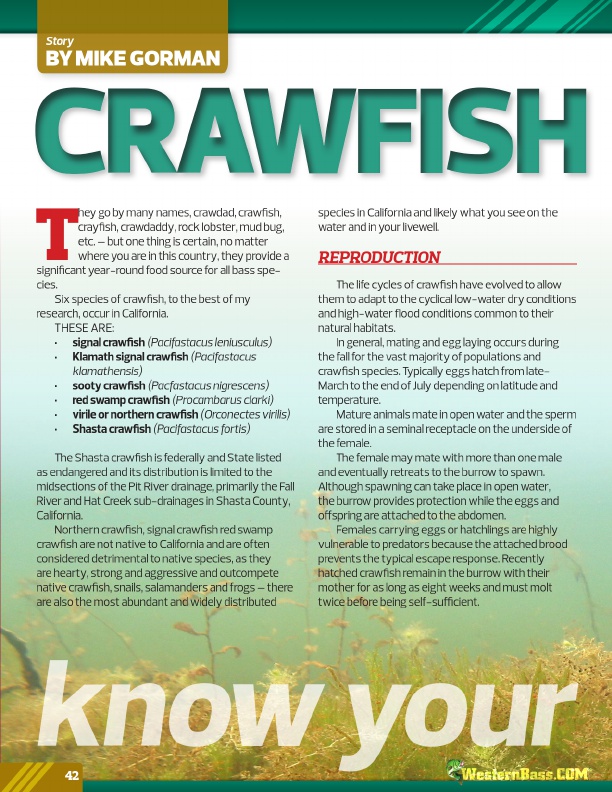
®
C kn R o A w W y F o IS u H r
Story
BY MIKE GORMAN
T
hey go by many names, crawdad, crawfish,
crayfish, crawdaddy, rock lobster, mud bug,
etc. – but one thing is certain, no matter
where you are in this country, they provide a significant year-round food source for all bass spe-
cies.
Six species of crawfish, to the best of my
research, occur in California.
THESE ARE:
• signal crawfish (Pacifastacus leniusculus)
• Klamath signal crawfish (Pacifastacus
klamathensis)
• sooty crawfish (Pacfastacus nigrescens)
• red swamp crawfish (Procambarus clarki)
• virile or northern crawfish (Orconectes virilis)
• Shasta crawfish (Pacifastacus fortis)
The Shasta crawfish is federally and State listed as endangered and its distribution is limited to the midsections of the Pit River drainage, primarily the Fall River and Hat Creek sub-drainages in Shasta County, California.
Northern crawfish, signal crawfish red swamp crawfish are not native to California and are often considered detrimental to native species, as they are hearty, strong and aggressive and outcompete native crawfish, snails, salamanders and frogs – there are also the most abundant and widely distributed
species in California and likely what you see on the water and in your livewell.
REPRODUCTION
The life cycles of crawfish have evolved to allow them to adapt to the cyclical low-water dry conditions and high-water flood conditions common to their natural habitats.
In general, mating and egg laying occurs during the fall for the vast majority of populations and crawfish species. Typically eggs hatch from late- March to the end of July depending on latitude and temperature.
Mature animals mate in open water and the sperm are stored in a seminal receptacle on the underside of the female.
The female may mate with more than one male and eventually retreats to the burrow to spawn. Although spawning can take place in open water, the burrow provides protection while the eggs and offspring are attached to the abdomen.
Females carrying eggs or hatchlings are highly vulnerable to predators because the attached brood prevents the typical escape response. Recently hatched crawfish remain in the burrow with their mother for as long as eight weeks and must molt twice before being self-sufficient.
42